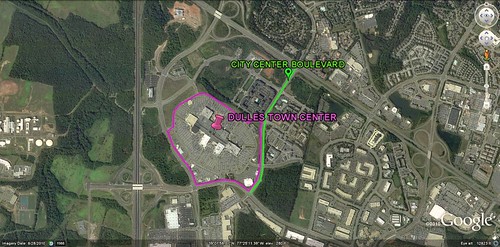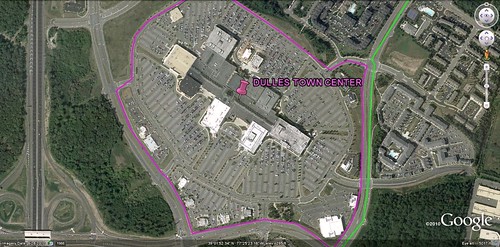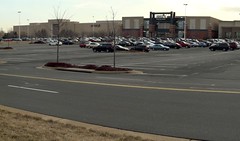What's In A Name? "Dulles Town Center" Neither Town Nor Center
I begin today's post with some context: over the weekend I went to a birthday party for a smart and fun 13-year-old in my extended family, with three other kids and three other grownups. It was at a fun restaurant and the company was swell. I had an excellent time, and it took my mind away from the terror of my impending return to work after a longish vacation.
The only fly in the ointment, so to speak, was the nearly 60-mile drive round trip from our house in the city out to the far suburbs, where the restaurant was, and back. I wasn't about to complain, though, because for one thing it isn't a very nice thing to do; and, for another, absolutely nothing about a long drive in the suburbs to a kids' event would have seemed remarkable in the least to my adult companions, who are deeply committed suburbanites. For them, it's just part of ordinary daily life, like waking up and having breakfast. Walking or taking transit to an event, now that would have been remarkable.
The restaurant was at a place called Dulles Town Center. To get there we went out the Dulles Toll Road and Virginia Route 28, took an exit, approached a road named City Center Boulevard, and pulled into a parking space near the restaurant.
The names Dulles Town Center and City Center Boulevard struck me as wildly ironic, if sadly familiar: where we were, there is no town; there is no center; there is no real boulevard; and there is certainly no city. What there is, is hundreds of acres of low-rise sprawl, giant parking lots, arterial roads with scary 70-mph traffic, and 1.4 million square feet of shopping space in an enclosed mall. It is the mall, of course, that is named Dulles Town Center.
I'm not kidding when I say there is no town. There is a county (Loudoun, for some time one of America's fastest-growing), and then a bureaucratic artifice called a "census-designated place" that in this case apparently takes its name from the shopping mall. Sprawl may be dying at last, at least in its most egregious forms, but this excursion was a wake-up reminder that it ain't dead yet.
I'm not saying, by the way, that the ironically named "Town Center" is a terrible place, once you're there. I get a little freaked out when enclosed in huge shopping spaces, but I still would probably use it if I lived out there. It certainly has stores that I patronize in other locations.
But the whole thing got me thinking about the names that developers and marketers give to new places, frequently to evoke exactly what those places are not – or, worse, what they are no longer. We all know subdivisions with names like King Farm that replaced the actual King Farm, for example, or The Meadows where pavement has replaced the actual meadows.
I floated the idea for this blog post with friends, and Brenda volunteered that there is a big newish development near where she bicycles in Maryland called "Dunfarmin." No doubt. Jan reported that the joke near where she lives in North Carolina is that a subdivision called "Fox Run" is a reference to the one fox left who is running as fast as he can to get out of there.
I did a little internet research on the subject of naming new places and found plenty. This site, for example, reports a Saddle Ridge with no horses, a Paradise Park with no park, a Three Rivers Crossing miles from the nearest river, and a Canyon Lakes built on a dry hill.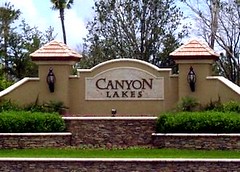
Shannon Register's real estate blog reports that researchers from the University of Georgia "analyzed MLS Sales Data in Baton Rouge, Louisiana between 1984 and 2005 and found that buyers were willing to pay a premium of 4.2 percent for a property with 'country' in the name and an additional 5.1 percent for the phrase 'country club'."
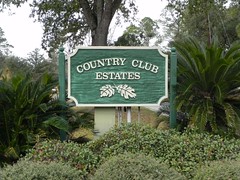
Azalea Estates
Breezy Highlands
Fairford Overlook
Magnolia Parish
Breadfruit Inlet
If you're in a particularly subversive mood, you can ask it to generate negative names:
Scavenger Swamp
Buzzard Bog
Fetid Bottoms
Smelly Gully
Monsoon Depression
Fun, no? Now, back to "town center," we actually do have some places in the DC suburbs 
And, in fact, that may be the direction in which Dulles Town Center wants to head. Earlier this year Erika Jacobson Moore wrote in the Loudoun Business section of the local news site Leesburg Today that the mall's owner has proposed to build over 1600 new multifamily homes and up to 5.5 million square feet of commercial space on land adjacent to the mall, along with a public park, "a mass transit facility," and a commuter parking lot. According to Jacobson Moore's article, a spokesperson for the developer put it this way:
"Now it is a suburban style development. It is a relic of the past [DTC opened in 1999]. If you look at the sea of parking and the asphalt, we thought it would be better to have an integrated, alive facility."
As things stood when the article was written, county planners were apparently opposed and the commissioners apparently divided. The proposal probably points in the right direction, and likely will be approved in some fashion; but the scale seems awfully ambitious to me given the dismal state of the real estate economy. I wouldn't expect much change anytime soon.
Meanwhile, the name of the short road that links the site's City Center Boulevard to the Town Center itself? "Mirage Way."
Move your cursor over the images for credit information.


